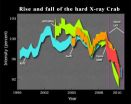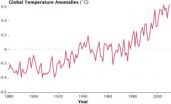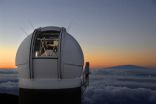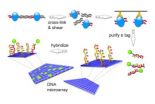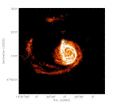(Press-News.org) The combined data from several NASA satellites has astonished astronomers by revealing unexpected changes in X-ray emission from the Crab Nebula, once thought to be the steadiest high-energy source in the sky.
"For 40 years, most astronomers regarded the Crab as a standard candle," said Colleen Wilson-Hodge, an astrophysicist at NASA's Marshall Space Flight Center in Huntsville, Ala., who presented the findings today at the American Astronomical Society meeting in Seattle. "Now, for the first time, we're clearly seeing how much our candle flickers."
The Crab Nebula is the wreckage of an exploded star whose light reached Earth in 1054. It is one of the most studied objects in the sky. At the heart of an expanding gas cloud lies what's left of the original star's core, a superdense neutron star that spins 30 times a second. All of the Crab's high-energy emissions are thought to be the result of physical processes that tap into this rapid spin.
For decades, astronomers have regarded the Crab's X-ray emissions as so stable that they've used it to calibrate space-borne instruments. They also customarily describe the emissions of other high-energy sources in "millicrabs," a unit derived from the nebula's output.
"The Crab Nebula is a cornerstone of high-energy astrophysics," said team member Mike Cherry at Louisiana State University in Baton Rouge, La. (LSU), "and this study shows us that our foundation is slightly askew." The story unfolded when Cherry and Gary Case, also at LSU, first noticed the Crab's dimming in observations by the Gamma-ray Burst Monitor (GBM) aboard NASA's Fermi Gamma-ray Space Telescope.
The team then analyzed GBM observations of the object from August 2008 to July 2010 and found an unexpected but steady decline of several percent at four different "hard" X-ray energies, from 12,000 to 500,000 electron volts (eV). For comparison, visible light has energies between 2 and 3 eV.
With the Crab's apparent constancy well established, the scientists needed to prove that the fadeout was real and was not an instrumental problem associated with the GBM. "If only one satellite instrument had reported this, no one would have believed it," Wilson-Hodge said.
So the team amassed data from the fleet of sensitive X-ray observatories now in orbit: NASA's Rossi X-Ray Timing Explorer (RXTE) and Swift satellites and the European Space Agency's International Gamma-Ray Astrophysics Laboratory (INTEGRAL). The results confirm a real intensity decline of about 7 percent at energies between 15,000 to 50,000 eV over two years. They also show that the Crab has brightened and faded by as much as 3.5 percent a year since 1999.
The scientists say that astronomers will need to find new ways to calibrate instruments in flight and to explore the possible effects of the inconstant Crab on past findings. A paper on the results will appear in the Feb. 1 issue of The Astrophysical Journal Letters.
Fermi's other instrument, the Large Area Telescope, has detected unprecedented gamma-ray flares from the Crab, showing that it is also surprisingly variable at much higher energies. A study of these events was published Thursday, Jan. 6, in Science Express.
The nebula's power comes from the central neutron star, which is also a pulsar that emits fast, regular radio and X-ray pulses. This pulsed emission exhibits no changes associated with the decline, so it cannot be the source. Instead, researchers suspect that the long-term changes probably occur in the nebula's central light-year, but observations with future telescopes will be needed to know for sure.
This region is dominated by four high-energy structures: an X-ray-emitting jet; an outflow of particles moving near the speed of light, called a "pulsar wind"; a disk of accumulating particles where the wind terminates; and a shock front where the wind abruptly slows.
"This environment is dominated by the pulsar's magnetic field, which we suspect is organized precariously," said Roger Blandford, who directs the Kavli Institute for Particle Astrophysics and Cosmology, jointly located at the Department of Energy's SLAC National Accelerator Laboratory and Stanford University. "The X-ray changes may involve some rearrangement of the magnetic field, but just where this happens is a mystery."
The Crab Nebula is a supernova remnant located 6,500 light-years away in the constellation Taurus.
NASA's Fermi is an astrophysics and particle physics partnership managed by NASA's Goddard Space Flight Center in Greenbelt, Md., and developed in collaboration with the U.S. Department of Energy, with important contributions from academic institutions and partners in France, Germany, Italy, Japan, Sweden and the United States.
The GBM Instrument Operations Center is located at the National Space Science Technology Center in Huntsville, Ala. The team includes a collaboration of scientists from UAH, NASA's Marshall Space Flight Center in Huntsville, the Max Planck Institute for Extraterrestrial Physics in Germany and other institutions.
NASA Goddard manages Swift, RXTE and a guest observer facility for U.S. participation in the European Space Agency's INTEGRAL mission.
INFORMATION:
NASA satellites find high-energy surprises in 'constant' Crab Nebula
2011-01-14
ELSE PRESS RELEASES FROM THIS DATE:
NASA research finds 2010 tied for warmest year on record
2011-01-14
WASHINGTON -- Global surface temperatures in 2010 tied 2005 as the warmest on record, according to an analysis released Wednesday by researchers at NASA's Goddard Institute for Space Studies (GISS) in New York.
The two years differed by less than 0.018 degrees Fahrenheit. The difference is smaller than the uncertainty in comparing the temperatures of recent years, putting them into a statistical tie. In the new analysis, the next warmest years are 1998, 2002, 2003, 2006 and 2007, which are statistically tied for third warmest year. The GISS records begin in 1880.
The ...
New telescope is exploring solar system 'outback'
2011-01-14
In the outer reaches of our solar system lies a mysterious region far more remote and difficult to explore than the Australian outback. It remains the only part of our solar system not visited by spacecraft. Called the Kuiper Belt, this area beyond Neptune is home to the dwarf planets Pluto, Eris, Makemake, and Haumea. It also harbors thousands of smaller objects that form a second, icy asteroid belt (or more appropriately, comet belt). In this realm of perpetual twilight, the distant sun looks like just another bright star.
A new telescope has begun to virtually explore ...
Deep genomics
2011-01-14
In 2003, the year a complete draft of the human genome was released, the U.S. National Human Genome Research Institute launched the ENCODE project (ENCyclopedia of DNA Elements), to develop an encyclopedia of the epigenome, that is, of all of the many factors that can change the expression of the genes without changing the genes.
Four years later, the National Institutes of Health funded modENCODE (the Model Organism ENCylopedia of DNA Elements) to work out the epigenomes of two model organisms: the fruit fly Drosophila melanogaster, lurker among rotten bananas, and the ...
Why coffee protects against diabetes
2011-01-14
Coffee, that morning elixir, may give us an early jump-start to the day, but numerous studies have shown that it also may be protective against type 2 diabetes. Yet no one has really understood why.
Now, researchers at UCLA have discovered a possible molecular mechanism behind coffee's protective effect. A protein called sex hormone–binding globulin (SHBG) regulates the biological activity of the body's sex hormones, testosterone and estrogen, which have long been thought to play a role in the development of type 2 diabetes. And coffee consumption, it turns out, increases ...
Skin provides Australia's first adult stem cells for rare genetic disease
2011-01-14
Scientists have developed Australia's first adult induced pluripotent stem cell lines using skin biopsies from patients with the rare genetic disease Friedreich Ataxia (FA).
The study was conducted by the University of Melbourne and Monash Institute of Medical Research and is published in the current online edition of the international journal Stem Cell Reviews and Reports. It is the first time adult pluripotent stem cells, known as iPS cells have been developed for a specific disease in Australia, allowing for the development of new treatments for FA and related conditions ...
Fruit fly nervous system provides new solution to fundamental computer network problem
2011-01-14
PITTSBURGH—The fruit fly has evolved a method for arranging the tiny, hair-like structures it uses to feel and hear the world that's so efficient a team of scientists in Israel and at Carnegie Mellon University says it could be used to more effectively deploy wireless sensor networks and other distributed computing applications.
With a minimum of communication and without advance knowledge of how they are connected with each other, the cells in the fly's developing nervous system manage to organize themselves so that a small number of cells serve as leaders that provide ...
GM chickens that don't transmit bird flu developed
2011-01-14
Chickens genetically modified to prevent them spreading bird flu have been produced by researchers at the Universities of Cambridge and Edinburgh.
The scientists have successfully developed genetically modified (transgenic) chickens that do not transmit avian influenza virus to other chickens with which they are in contact. This genetic modification has the potential to stop bird flu outbreaks spreading within poultry flocks. This would not only protect the health of domestic poultry but could also reduce the risk of bird flu epidemics leading to new flu virus epidemics ...
Overexpression of repetitive DNA sequences discovered in common tumor cells
2011-01-14
Massachusetts General Hospital (MGH) Cancer Center researchers have discovered a previously unknown feature of common tumor cells – massive overexpression of certain DNA sequences that do not code for proteins. These DNA sequences – called satellite repeats – have been studied for their role in chromosomal structure but previously were not suspected of having a role in cancer. The report will appear in the journal Science and is receiving early online release.
"Satellite repeats make up a large part of our genome but had been thought to be inactive," explains David ...
When a kidney transplant fails, home-based dialysis is an option
2011-01-14
Patients returning to dialysis after kidney transplant failure present unique challenges compared with other dialysis patients: they have been exposed to very powerful immunosuppressive medications and have been on dialysis for a longer period of time than other dialysis patients. This puts them at particularly high risk for various complications and death. According to a study appearing in an upcoming issue of the Clinical Journal of the American Society Nephrology (CJASN), despite complications, these patients can choose to undergo dialysis in the comfort of their own ...
Forget Planet X! New technique could pinpoint Galaxy X
2011-01-14
Planet X, an often-sought 10th planet, is so far a no-show, but Sukanya Chakrabarti has high hopes for finding what might be called Galaxy X – a dwarf galaxy that she predicts orbits our Milky Way Galaxy.
Many large galaxies, such as the Milky Way, are thought to have lots of satellite galaxies too dim to see. They are dominated by "dark matter," which astronomers say makes up 85 percent of all matter in the universe but so far remains undetected.
Chakrabarti, a post-doctoral fellow and theoretical astronomer at the University of California, Berkeley, has developed ...
